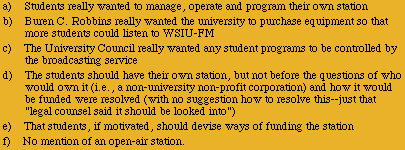 |
||||||
 |
||||||
 |
||||||
 |
||||||

part II
| By May, 1965, Fred Lueck, still at SIU, had found some help. Fred prepared a new proposal, but this time, he had lined up all the dorm presidents, Student Council, Student Body President, and all of them had endorsed the proposal. In fact, they had created a "Committee for Closed Circuit Radio," of which Fred and Mike McDaniel were co-chairs. This new proposal had these key features: | |||||||||||
 |
|||||||||||
| This proposal was submitted to Dr. John Anderson, whose title was "Executive Director, Communications Media." It appears that he was superior to the Director of the Broadcasting Service. He authorized a study on this matter by Ira McDaniel, Director of Broadcast Engineering at Oklahoma State University. McDaniel's report was issued in August, 1965. His conclusion was remarkably astute and prophetic: | |||||||||||
| The possibility of an open-air transmission system should be considered. Such a system would give full campus and off-campus coverage regardless of growth trends. The system would be central in nature and therefore require less material and manpower to operate it. The first costs would be lower for the open-air system. Problems with the FCC (about excessive radiation from carrier-current transmitters) would be all but eliminated. If an open-air station should happen to be commercial, the operators of the local station would be duly concerned, but that would be the case even with a current-carrier station. It should be decided which will be of the greatest concern.....the operator's (university's) interest, or the interests of the student body. The open-air system would seem to be the only sound system to merit consideration if a frequency is available and the author is sure there is. The author estimates that at the present rate in which FM channels are being filed upon in Oklahoma, there will be none left by 1969. The situation in Illinois is probably more acute. The possibility of a commercial FM for Carbondale, and both a commercial and non-commercial educational FM for Edwardsville should be considered. Once these frequencies are gone, it is probable that they will never again be available............ especially to educators. |
|||||||||||
| Sadly, this cogent and prescient analysis was obscured in an avalanche of discordant proposals, committee recommendations, and other reports. To his credit, Dr. Anderson tried to corral the issues by identifying many interested persons, rendering sets of copies of all relevant documents to them, and assembling them in an attempt to fashion some form of consensus. At this point, Dr. Anderson had assembled all the documents described so far. But there was a lot more. In addition to their proposal to "amend the broadcasting service budget," Lueck and McDaniel also submitted a document titled "Managerial Breakdown and Job Description of the Station Operating Policy of the Proposed Student Carrier-Current Radio Station." A company called "H & R Broadcasting" submitted a proposal that they would operate the campus student station. John Kurtz and Buren C. Robbins presented a document entitled: "WINI--prepared for Carrier-Current." There was a copy of a study from Michigan State University about their situation. There was a new (kind of half-baked) proposal for "Radio Thompson Point" that would feature, among other things, "announcements and music during meal times." Dr. Anderson was charged with the duty to render a report on this to Ralph Ruffner, Vice President for Student and Area Services. During a trip to Hawaii and Tokyo, Dr. Anderson wrote his report. While in Katmandu, Nepal, he wrote a letter "expressing his dismay" that the report had not been received yet. His report finally "turned up" in mid-November, 1966. The long awaited conclusions were not surprises. The report stated: |
|||||||||||
 |
|||||||||||
| The report did not recommend any action, except that Robbins' idea (to make WSIU-FM available in dorms) should be funded, as it might "aid instruction," and that WSIU do more to program to student needs. After five years of meetings, proposals, studies, reports, and analysis, the great organization and brainpower of the university responded to an obvious student need for a student radio station by suggesting further study, and spending money to obtain a student (possibly captive) audience for WSIU. The WSIU-FM receivers-in-the-dorms idea never happened. It is unknown if there was any follow up by legal counsel to "look into" aspects of outside ownership and funding methods of a student station. Lueck and McDaniel eventually left SIU, possibly as graduates. There was some outraged reaction to Dr. Anderson's report. Some faculty stated the obvious---the university had failed the students. It had taken five years to accomplish nothing. The school was no closer to a student radio station and/or a radio service serving student needs than it had been in 1962, or, for that matter, 1862. Generations of students had arrived and departed C'dale and there was still no local radio for students, for service, for experience, for anything. Supposedly structured for efficiency, the administration and bureaucracy had spun its wheels, passed the buck, ignored its own paid consultants, engendered territorial battles, and completely disregarded students' needs. The administration and bureaucracy refused to prioritize students' needs over administrative convenience. They ignored the efficiency of open-air broadcasting and procrastinated, stalled, and delayed. This is how they "served" their paying customers--the students. |
|||||||||||
end of Chapter 10
|
|||
|
|
|||
|
Message Board | The Source Contact |